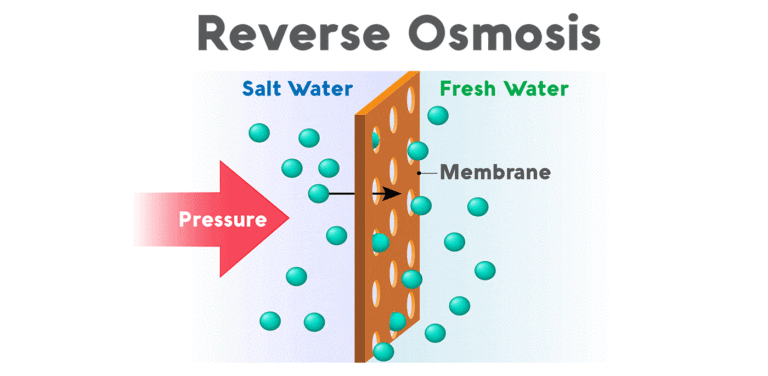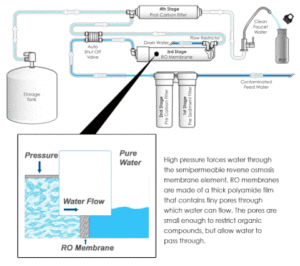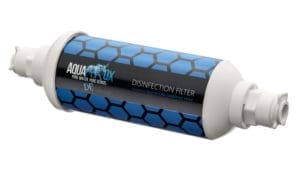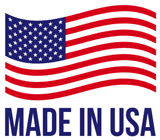
Table of Contents
Investing on a reverse osmosis water filtration system for your home or business establishment can be expensive. This is why knowing more about it’s process and advantages as well as the downsides of having one is important.
Shopping for the perfect RO water filtration system would be so much easier when you know the specific type of RO filter that you want to get. So, what is reverse osmosis? To put simply, reverse osmosis is one of the most effective ways to filter out any contaminants in your drinking water.
Compared to other water filtration methods, reverse osmosis is relatively cheaper and much easier to maintain. Despite the efforts of your local government to keep tap water clean and safe, you can never be too sure that all contaminants have been removed.
This is why having your own water filtering system is vital for the safety of the people that consume your drinking water on a daily basis. This article will give you factual insights of everything you need to know about the reverse osmosis water filtering system.
What is Reverse Osmosis Filtration?
Put simply, dirt, particles and chemicals like chlorine are filtered out by a pre-filter which is usually an activated carbon filter before it is pushed through a semipermeable media.This semipermeable media filters out dissolved chemicals.
The water then passes through a postfilter to polish the water making sure that the contaminants have been fully-filtered out. Reverse osmosis water filters can have various stages depending on the amount of filters you would want your system to have for pre- and postfilter processes.

How Reverse Osmosis Really Works
Each stage of the Reverse Osmosis water filter system plays a vital role in eliminating contaminants. Here is a complete process of the stages water undergoes in order to become safe for consumption.
These are the most common filters included in the stages of the RO filter system:
Sediment Filters: mainly removers dirt, stone and other larger particles floating in the water.
Activated Carbon Filters: removes organic volatile compounds and chlorine form the water. These types of filters also get rid of substances that give water a foul odor and taste.
Semipermeable Media: eliminates almost 98% of TDS (totally dissolved substances) like manganese, sulfates and other inorganic salts.
Here is a video that shows and explains the whole reverse osmosis process with the water filtration system.`
What Does Reverse Osmosis Filters Remove?
Reverse osmosis filters are not fool-proof. There are some substances that can’t be eliminated using RO systems. But it is by far, the most effective stand-alone method for filtering water, making it safe for consumption.
Although some of the substances here are normally found in the body, some of these minerals in increased levels can cause serious illnesses. Here is a list of all the chemicals and other contaminants that the RO filter system can eliminate.
Contaminants Removed Using the Reverse Osmosis Filtration System
Inorganic Salts (Sodium, Bicarbonate, Calcium, Chlorides, Sulfates, Calcium, Potassium and Magnesium)
Volatile Organic Compounds (Acetone, Acetic Acid, Alcohol, etc.)
Chlorine (disinfectant)
Herbicides and Pesticides
Arsenic (naturally and artificially-occurring)
Fluoride
History of Reverse Osmosis Water Filtration Method
The reverse osmosis method is not really a new method for filtering water. The very first sighting of the use of this method dates back to 1959. Finding new drinking water sources was the main goal during that period.
With a goal of filtering desalinated water in mind, researchers Sidney Loeb and Srinivasa Sourirajan from UCLA developed a synthetic reverse osmosis membrane using cellulose acetate polymer.
Since this method functioned in reverse as compared to osmosis, it was called reverse osmosis. Osmosis works by letting a solvent like water pass through a semipermeable membrane from a less concentrated substance to a more concentrated one.
With reverse osmosis, a substance of higher concentration is forced into a semipermeable membrane letting only the solvent pass through while leaving behind the larger particles.
Since then, modern technology has been incorporated into these methods to create more efficient models of RO filter systems. With today’s technology, more and more benefits of using RO filter systems have emerged.
Pros and Cons of Reverse Osmosis Systems
A reverse osmosis water filtration system offers a lot of benefits due to its extensive filtration process. Since it filters out most of the contaminants in the water, it is one of the best methods that can be used as a stand-alone procedure.
But despite all the benefits it can bring to you and the people around you, it still has minor flaws. Below are the pros and cons of having a reverse osmosis water filtration system.
Reverse Osmosis Water Filter PROS:
Removes bad odor and improves taste: chemicals like chlorine and fluoride often tend to leave a bad odor and taste to water. Reverse osmosis helps in eliminating these chemicals thereby improving your drinking water’s taste drastically.
Removes 98% of TDS: These substances need to be reduced in order to avoid any hazardous reactions to the human body. Magnesium and calcium might be beneficial to the body but lead and copper have the potential to cause serious illnesses when consumed in high levels.
Cost effective: Compared to buying bottled waters from the supermarket, a reverse osmosis filter system is a more convenient and cost effective choice. Since a gallon of water will cost you less than bottled waters.
Energy efficient: This method does not require electricity to function making it efficient for usage since you won’t have to worry about your electric bill.
Easy maintenance: Replacing the filter cartridges and the semipermeable membrane is relatively easy and does not involve any complex procedures.
Reverse Osmosis Water Filtration CONS:
Prone to clogging: The semipermeable membrane’s pores tend to clog up easily especially when proper machine maintenance is not done periodically. This is why maintenance plays a vital role in keeping the system’s function 100% optimal.
Slow process: This method is not a quick process. It takes around 2 to 4 hours to fill a tank. Having a tank to store all the filtered water is a great choice to avoid having to wait for your filtration system to filter another batch.
Maintenance costs: The maintenance process might be easily and simple but having to replace it at specific times can still be a pain. Not to mention the expenses of having to buy new filter cartridges and semipermeable membranes.
Removal of essential minerals: Magnesium and calcium, which are very important minerals for the body, are also removed along with the 98% of TDS that are removed during the filtration process.
Bacteria and other microorganisms: The main downside of the RO filtration system is that it does not kill bacteria, viruses and other disease-causing pathogens.
How to Maintain a Reverse Osmosis System
Since the filters and semipermeable membrane need to have proper periodic maintenance, it is important to keep track of the schedules on the next maintenance. Aside from this, it is also necessary to sanitize the RO filtration system to keep the water clean.
The typical lifespan of an RO filtration system would be around 10 to 15 years when properly maintained. Here are the typical schedules for maintenance and sanitation of reverse osmosis water filtration systems:
Filter Cartridges – These cartridges need to be replaced after 6 to 9 months to maintain optimal functions.
Semipermeable Membranes – RO semipermeable membranes need to be changed after 2 to 3 years of use.
RO Filtration System Sanitation – Sanitizing the system should be done annually.
Overall, the reverse osmosis filtration method is a great and efficient way to have safe and clean drinking water. Also it has some minor flaws, its benefits can’t be overlooked. Unlike other filtration methods this is the best and most effective of them all.
Reverse Osmosis
We don’t recommend filtering the whole house with reverse osmosis if you need to remove a stubborn element. When you filter water through an RO system and then send it through the pipes in your homes plumbing, the RO made water will actually eat a hole in the pipe in your wall because it’s trying to get the natural elements back in it’s genetic make up. It becomes “aggressive” water.
What we recommend is using a whole house water filter and then filtering through RO at the point of your glass for drinking water. If you have a minute, checkout our line of whole house water filters.









